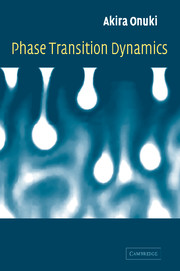6 - Dynamics in fluids
Published online by Cambridge University Press: 13 August 2009
Summary
In the dynamics of one- and two-component fluids near the critical point and 4He and 3He–4He near the superfluid transition, the dynamic equations of the gross variables are nonlinear Langevin equations with reversible nonlinear mode coupling terms. These terms represent nonlinear dynamic interactions between the fluctuations, which cause critical divergence of the kinetic coefficients. We will give intuitive pictures of the physical processes leading to such enhancement of transport and review the mode coupling and dynamic renormalization group theories. New results are presented on various adiabatic processes including the piston effect and supercritical fluid hydrodynamics near the gas–liquid critical point and on nonequilibrium effects of heat flow near the superfluid transition.
Hydrodynamic interaction in near-critical fluids
In the dynamics of nearly incompressible binary fluid mixtures it is usual to take the concentration deviation δχ as the order parameter ψ. In one-component fluids it is convenient to take the entropy deviation δs (per unit mass) as ψ, because δs is decoupled from the sound mode in the hydrodynamic description. In these fluids, the dynamics of the order parameter is slowed down but the kinetic coefficients are enhanced near the critical point. These features originate from random convection of the critical fluctuations by the transverse velocity field fluctuations [1]–[7].
Intuitive picture of random convection
The order parameter undergoes diffusive relaxation resulting from convective motion due to the velocity field fluctuations.
- Type
- Chapter
- Information
- Phase Transition Dynamics , pp. 227 - 316Publisher: Cambridge University PressPrint publication year: 2002
- 1
- Cited by

